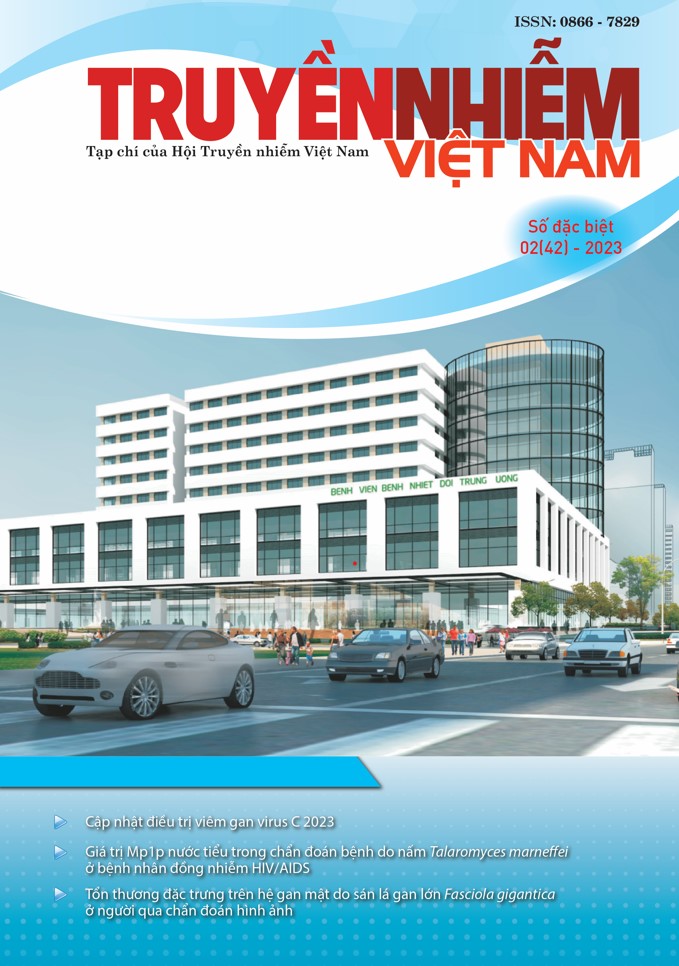LIVER INJURY IN ADULTS DENGUE PATIENTS
Main Article Content
Abstract
Background: Liver damage is common in Dengue fever. Starting from asymptomatic elevated transaminase levels to acute liver failure, dengue has all the properties of a hepatic illness. Hepatic manifestations are either a result of direct viral toxicity or dysregulated immunologic injury in response to the virus or hepatocellular hypoxia.
Aims: 1. To evaluate the clinical liver damage, liver function tests in adult dengue patients and 2. To evaluate the relationship between liver damage and severity of disease.
Subjects and methods: Cross-sectional descriptive study. Studied on 160 adult Dengue patients admitted to the Department of Tropical Diseases, Hue Central Hospital, from April 2019 to June 2020.
Results: Among the clinical features of hepatic involvement, patients have abdominal pain (25%), hepatomegaly (6.3%), jaundice (1.3%), encephalopathy (0%). Raised AST and ALT levels: 2 - 5 folds (36.9% and 29.4%), 5 - 15 folds (16.9% and 11.9%), more than 15 folds (6.2% and 2,5%) and 90.6% of patients have the ratio AST/ALT > 1. AST and ALT levels increase during day 3 - 6 and tend to decrease after 3 days (p < 0,05). Raised ALP levels (1.3%), hyperbilirubinemia (2.5%), decrease PT% (6.9%). The values of AST, ALT, and total bilirubin are different between the levels of dengue, increased in the form of warning signs and severe dengue (p < 0.05). Transaminase levels increased correlated with other markers of disease severity, such as gastrointestinal bleeding, shock and the decrease of platelet cout. Other risk factors of shock in dengue infection: abdominal pain, hepatomegaly, decreased prothrombin ratio.
Conclusions: Transaminase levels correlated with disease severity, such as gastrointestinal bleeding, shock and the decrease of platelet cout. Other risk factors of shock in dengue infection: abdominal pain, hepatomegaly, decreased prothrombin ratio.
Article Details
Keywords
Dengue infection, hepatic dysfuction, transaminase
References
2. Trần Xuân Chương (2019), Sốt xuất huyết Dengue, Giáo trình đại học Bệnh học Truyền nhiễm, Nhà xuất bản Đại học Huế, tr. 84-93.
3. Phạm Châu Duy (2012), Nghiên cứu đặc điểm lâm sàng, mức độ nặng và tổn thương gan ở bệnh nhân sốt xuất huyết Dengue, Luận án chuyên khoa cấp 2, Trường Đại học Y Dược Huế.
4. Phan Hữu Nguyệt Diễm (2004), Suy gan trong sốt xuất huyết trẻ em, Tạp chí Y học TP. Hồ Chí Minh,
8(1), tr 132-137.
5. Nguyễn Mạnh Hùng, Trần Thị Ngọc Ánh, Nguyễn Thị Kiều Anh (2018), Sự lưu hành và một số đặc điểm dịch tễ các týp virus Dengue gây bệnh sốt xuất huyết tại Hà Nội giai đoạn 2015 - 2017, Tạp chí Y học dự phòng, 28(5), tr 88-96.
6. Đặng Thị Thúy, Bùi Vũ Huy, Đỗ Thị Thanh Thủy (2014), Tổn thương gan trong bệnh sốt xuất huyết
Dengue ở người trưởng thành, Tạp chí Nghiên cứu Y học, 88(3), tr. 55-60.
7. Balakumar J., Balasubramaniyan S., Paari N. (2019), Study of serum aminotransferase levels in dengue fever and its correlation, Journal of Medical Science and Clinical Research, 7(11), pp. 36-41.
8. Bashir A.B., Saeed O.K., Mohammed B.A., Ageep A.K. (2015), Partial thromboplastin time and
prothrombin time as predictors for impaired coagulation among patients with dengue virus infection in Red Sea State of Sudan, International Journal of Hematological Disorders, 2(1), pp. 24-28.
9. Chhina R.S., Goyal O. et al (2008), Liver function tests in patients with dengue viral infection, Dengue
Bulletin, 32, pp. 110-117.
10. Dinh The Trung, Le Thi Thu Thao et al (2010), Liver involvement associated with dengue infection in
adults in Vietnam, Am J Trop. Med Hyg, 83(4), pp. 774-780.
11. Fernando S., Wijewickrama A., Laksiri G. et al (2016), Patterns and causes of liver involvement in acute dengue infection, BMC Infectious Disease, 16, pp. 319.
12. Lee L.K., Gan V.C. et al (2012), Clinical relevance and discriminatory value of elevated liver
aminotransferase levels for dengue severity, PloS Negl Trop Dis, 6(6), pp. 1676-1682.
13. Narasimhan D., Ponnusamy P., Sathish M. (2018), Analysis of liver function tests in dengue fever,
International Journal of Advances in Medicine, 5(1), pp. 47-49.


